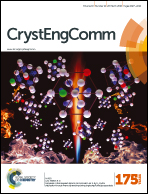Influence of Ta5+ content on the crystallographic structure and electrical properties of [001]PC-oriented (Li,Na,K)(Nb,Ta)O3 single crystals
Abstract
A series of centimeter-sized lead-free piezoelectric Li+- and Ta5+-modified (Na,K)NbO3 single crystals with an ABO3 perovskite structure was successfully grown by the top-seeded solution growth method. Effective segregation of the elements was considered in order to further develop the growth of Li+- and Ta5+-modified (Na,K)NbO3 single crystals. The crystallographic structure and electrical behaviour along the [001]PC orientation were studied. X-ray diffraction, Raman spectroscopy and dielectric studies reveal that the increase in Ta5+ content reduces the orthorhombic–tetragonal phase transition. Bipolar and unipolar strain curves were investigated at 2 kV mm−1. The highest bipolar and unipolar strains associated with a large-signal piezoelectric constant of 368 pm V−1 were achieved for Li0.02Na0.626K0.354Nb0.808Ta0.192O3. The asymmetric bipolar strain curves were observed and related to the existence of internal bias fields induced by  defect dipoles, which were created during the crystal growth process.
defect dipoles, which were created during the crystal growth process.
![Graphical abstract: Influence of Ta5+ content on the crystallographic structure and electrical properties of [001]PC-oriented (Li,Na,K)(Nb,Ta)O3 single crystals](/en/Image/Get?imageInfo.ImageType=GA&imageInfo.ImageIdentifier.ManuscriptID=C5CE02581H&imageInfo.ImageIdentifier.Year=2016)


 Please wait while we load your content...
Please wait while we load your content...